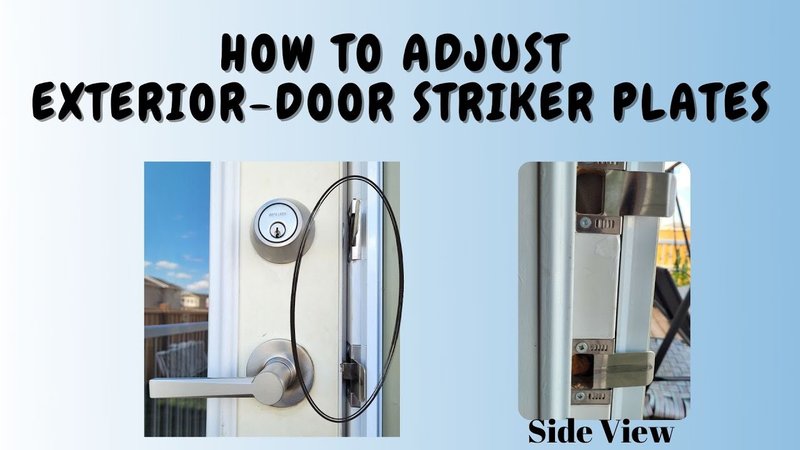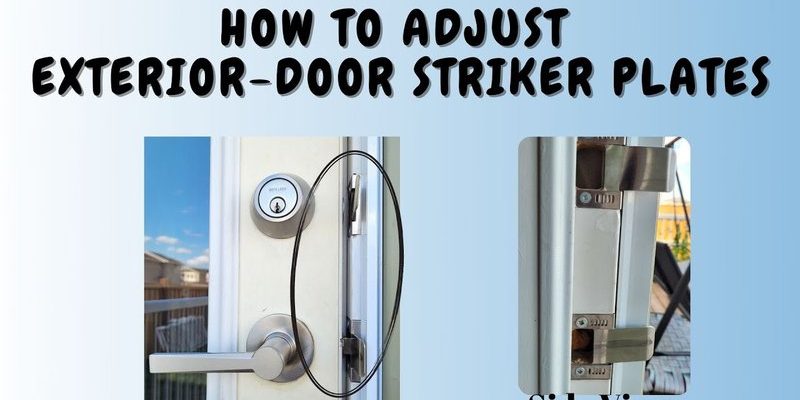
In this journey of door adjustments, you’ll discover a range of tools, from simple screwdrivers to handy templates. Each one has its unique role in ensuring your strike plate is aligned perfectly. And trust me, it’s easier than it sounds! Let’s dive into the world of tools you can use to make your door operate like new again.
Before we dive into the tools, let’s take a moment to understand what a strike plate is. Essentially, it’s a metal plate installed on the door frame where the bolt or latch of the door engages. Think of it as the welcome mat for your door lock. If the strike plate is misaligned, it can cause problems like difficulty locking the door or a door that doesn’t close all the way.
Why does it matter? Well, a properly adjusted strike plate can enhance your home’s security and energy efficiency. If air leaks through gaps, you might find your heating bill rising in winter! So, adjusting it to the right position is crucial for both functionality and comfort.
Now that we have a grasp of what a strike plate does, let’s talk about the tools you’ll need to adjust it accurately. Here’s a rundown of the essentials:
- Screwdriver: A standard Phillips or flathead screwdriver is usually enough to loosen or tighten the strike plate screws. Having a magnetic screwdriver can save you from dropping screws!
- Chisel: If you need to deepen the strike plate’s cutout, a chisel can help create a perfect fit. This tool is crucial for minor adjustments.
- Drill: Occasionally, you might need to make new holes for the screws. A drill will help you do this quickly and cleanly.
- Level: To ensure the plate is aligned correctly, a level can help you see if it’s straight. This is especially useful if your door frame isn’t perfectly square.
- Measuring Tape: Precise measurements are key. A measuring tape helps you ensure your strike plate is positioned correctly relative to the door latch.
Each of these tools plays a vital role in making your adjustments efficient. Having the right tools on hand can make all the difference.
It might sound daunting, but adjusting a strike plate can be quite straightforward. Let’s break it down into manageable steps:
First things first, gather all the tools we just discussed. Having everything at your fingertips will save you time and keep the process smooth.
Next, examine the placement of your strike plate. Is it sitting flush against the door frame? Open and close the door a few times to see where it catches or if the latch aligns improperly. This will give you clues on where adjustments are needed.
Using your screwdriver, loosen the screws holding the strike plate in place. Don’t remove them completely—just enough to allow some wiggle room.
This is the moment where you make your adjustments! If the plate is high, push it down slightly; if it’s low, raise it. You can also adjust it horizontally if needed. Use your level to ensure it’s straight.
Once you’re happy with its placement, tighten the screws securely. Make sure it’s snug, but don’t overtighten, as this could cause damage.
Now for the moment of truth! Close the door and check the latch. It should engage smoothly without resistance. If it doesn’t, you might need to make minor adjustments again.
You may not know this, but there are different types of strike plates designed for various applications. Understanding these can help you choose the right one if you need to replace it in the future.
- Standard Strike Plate: The most common type, designed for standard door locks.
- Deadbolt Strike Plate: Heavier and stronger, these plates are made for deadbolts and offer extra security.
- Safety Strike Plate: Often used for exterior doors, these plates include additional features to prevent tampering.
- Extended Strike Plate: This provides a larger surface area, which can be helpful for reinforcing weak door frames.
Choosing the right type ensures not only your door operates smoothly but also maintains security.
Sometimes, adjusting a strike plate doesn’t solve the misalignment issue. Here are a few common problems and how to troubleshoot them:
- Door Doesn’t Latch: If the door doesn’t latch even after adjustment, it could be an issue with the door frame or hinges. Inspect those areas for wear.
- Misalignment Returns: If the strike plate keeps going out of alignment, check for loose screws or consider replacing the strike plate entirely.
- Door Sticking: If it’s sticking when you attempt to close it, you might need to adjust the door hinges as well.
Taking the time to troubleshoot can save you frustration and ensure a seamless door operation.
Once you’ve adjusted your strike plate, it’s a good idea to keep it in good shape. Here are some tips for maintenance:
- Regular Inspections: Check your door and strike plate every few months to catch any issues early.
- Lubrication: A little lubricant can help keep the latch operating smoothly. Use a silicone spray or graphite for best results.
- Reinforce with Screws: If you notice wear over time, consider replacing the screws with longer ones for added security.
Maintaining your strike plate ensures it stays functional and provides peace of mind for your home’s security.
In conclusion, adjusting a door strike plate might seem simple, but it can make a significant difference in your door’s performance and security. By using the right tools and following these steps, you’ll have a door that closes and locks perfectly. Remember, a well-adjusted strike plate not only enhances your security but also improves your home’s overall energy efficiency. So grab your tools and get to work—you’ll be amazed at how satisfying it is to solve this common problem!
